In the rapidly evolving realm of digital marketing, Artificial Intelligence (AI) is emerging as a game-changer, particularly in the sphere of email marketing and automation. Gone are the days of generic, one-size-fits-all email campaigns. Today, AI is enabling marketers to deliver highly personalized, timely, and effective emails that resonate deeply with individual recipients. At the heart of this transformation is Prism Reach, an innovative AI-powered SaaS solution designed to elevate email marketing strategies through advanced personalization and automation. This comprehensive article delves into how AI is reshaping email marketing, explores five “hidden gem” strategies that hold significant potential, and highlights the pivotal role of tools like Prism Reach in driving marketing success.
Key Facts
- AI-powered tools can boost email open rates by up to 40% through personalized content and optimal send times.
- Marketers using AI for automation report an average time savings of 3-4 hours per week on routine tasks.
- Companies implementing AI in their marketing strategies see an average increase in ROI of up to 30%.
- AI-driven segmentation can lead to a 40% increase in conversion rates.
- Integrating AI chatbots into email campaigns can result in a 25% boost in engagement.
The Dawn of Intelligent Email Marketing
The traditional approach to email marketing often involved sending the same message to a broad audience, relying on basic segmentation like demographics. However, AI is revolutionizing this landscape by enabling hyper-personalization that goes far beyond simple name insertion.
Prism Reach exemplifies this shift by leveraging AI-driven dynamic content generation. This feature allows emails to automatically adjust their content in real-time based on each recipient’s past interactions and preferences. Such deep personalization not only enhances engagement but also fosters a stronger connection between brands and their audiences.
Optimizing for Success
One of the most impressive capabilities of AI in email marketing is its ability to determine the optimal send time for each individual subscriber. Traditional methods relied on general best practices or gut feelings, but AI analyzes engagement patterns to predict when each recipient is most likely to open and interact with an email.
Implementing AI-driven send time optimization, as offered by Prism Reach, can lead to a 22% increase in overall engagement rates. This feature acts like a personal assistant, ensuring your messages reach subscribers when they are most receptive.
Upgrade Your Email Marketing with AI Personalization!
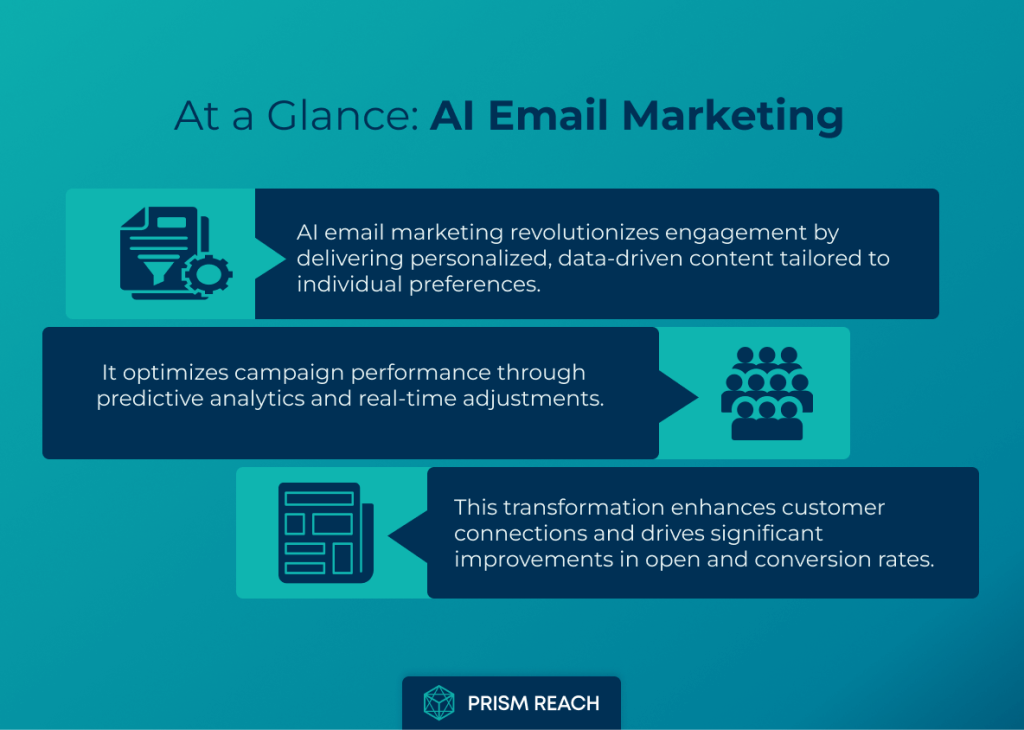
Five Hidden Gem Strategies in AI Email Marketing
1. Emotionally Driven Subject Lines
The subject line is the first impression your email makes, and crafting one that resonates emotionally can significantly impact open rates. AI tools like IBM Watson Tone Analyzer evaluate the emotional tone of subject lines, allowing marketers to create emotionally charged statements that capture attention and encourage engagement.
Prism Reach integrates emotionally intelligent subject line generation, ensuring each email starts with a powerful, emotionally resonant statement tailored to the recipient’s psychological triggers.
2. Automated Content Personalization
AI excels at analyzing user behavior and preferences to create hyper-personalized email content dynamically. This means that instead of a one-size-fits-all approach, each recipient receives tailored messages based on their interactions and interests, leading to higher engagement and conversion rates.
With Prism Reach, marketers can effortlessly implement automated content personalization. The platform analyzes subscriber data to deliver personalized content blocks, ensuring each email is relevant and engaging to the individual recipient.
3. Predictive Engagement Scoring
Understanding which leads are most likely to engage or convert is crucial for prioritizing marketing efforts. AI-driven predictive analytics can score leads based on their likelihood to interact with your emails, enabling marketers to focus their outreach on high-potential prospects.
Prism Reach utilizes predictive engagement scoring to identify and prioritize leads, ensuring that marketing resources are allocated efficiently to maximize campaign effectiveness.
4. Behavioral Trigger Emails
Behavioral trigger emails are automated responses to specific user actions, such as browsing behavior or cart abandonment. AI insights enable these emails to be highly targeted and timely, significantly boosting conversion rates by reaching users at critical moments in their buying journey.
Through Prism Reach, marketers can set up behavioral trigger emails that are automatically sent based on real-time user actions, ensuring timely and relevant communication that drives conversions.
5. Real-Time A/B Testing
A/B testing is essential for optimizing various email elements, such as subject lines and content formats. AI can conduct real-time A/B tests, analyzing performance data instantaneously and allowing marketers to adapt campaigns on-the-fly for maximum engagement.
Prism Reach offers real-time A/B testing capabilities, enabling continuous optimization of email campaigns without manual intervention. This ensures that each campaign iteration performs better than the last, enhancing overall effectiveness.
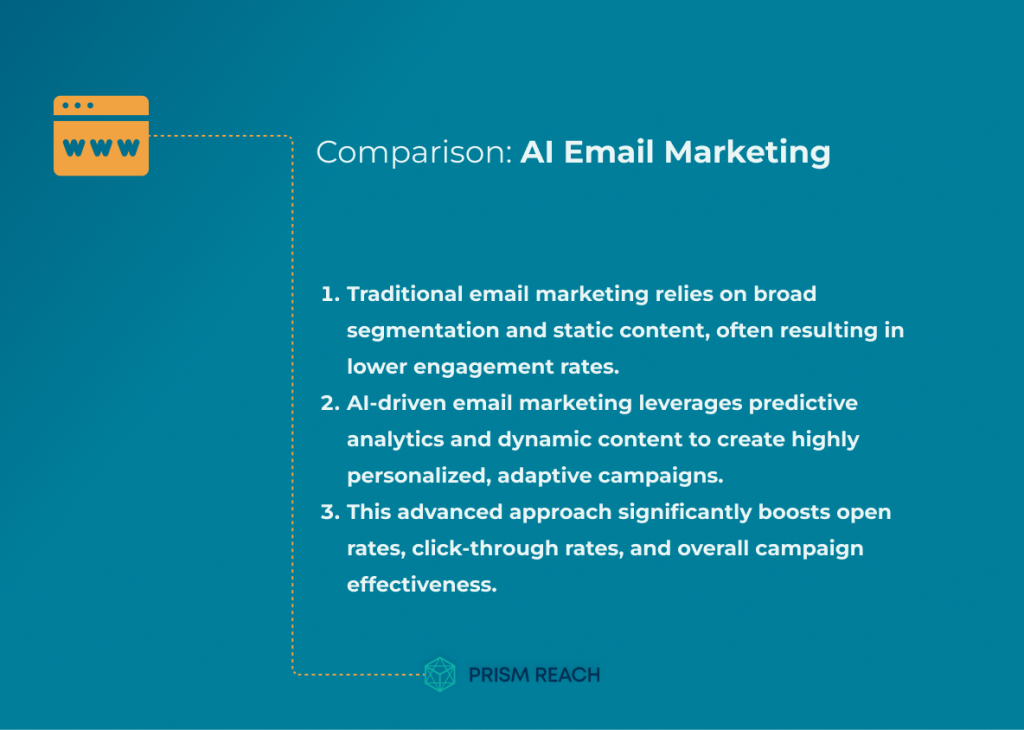
Prism Reach: Elevating AI Email Marketing
Prism Reach stands out as a comprehensive AI-powered solution designed to enhance email marketing campaigns through deep personalization and automation. By integrating sophisticated AI algorithms, Prism Reach transforms how publishers and content creators engage with their audiences, offering a suite of features that drive higher engagement, increased revenue, and improved productivity.
Company and Product Overview
Prism Reach’s core functionality revolves around its proprietary AI technology, which clusters website content and social media posts into relevant categories. This AI utilizes a variety of data points to create detailed user avatars, enabling personalized newsletter content that incorporates factors such as location, engagement history, and predicted interests. The system’s ability to analyze vast amounts of data allows for highly targeted marketing strategies that are both efficient and effective.
Target Audience
The primary users of Prism Reach are publishers across various platforms, including international media outlets, blogs, and forums. Additionally, the company is expanding into the eCommerce sector, aiming to leverage its technology to enhance digital marketing efforts in this rapidly growing area.
Key Features
- AI-Powered Personalization:
- Content Clustering: Utilizes both open and proprietary AI models to categorize content effectively.
- User Avatars: Enriches user data for creating highly personalized profiles.
- Personalized Introductions: Generates custom introduction paragraphs for each subscriber using advanced data analytics.
- Optimal Sending Times: Uses predictive analytics to determine the best times to send newsletters, maximizing subscriber engagement.
- Seamless Setup and Integration:
- Quick Setup: The platform can be integrated within 10 minutes, making it user-friendly.
- One-Click Uploads: Facilitates easy migration of existing subscriber lists.
- AI-Enhanced Sign-Up Forms: These forms are designed to increase sign-up rates through AI-generated content tailored to the user’s context and improve GDPR compliance.
- Dynamic Content Selection:
The AI determines the most relevant content for each subscriber, enhancing the personalization of each newsletter. - Advertising Network and Swap Network:
- Provides a platform for targeted advertising similar to major online ad networks, allowing for precise ad placement based on subscriber data.
- Facilitates mutual promotion among publishers, broadening content reach and enhancing subscriber engagement.
- Advanced AI Features:
- Includes anti-spam checks and a focus on high deliverability, crucial for maintaining engagement levels and avoiding spam filters.
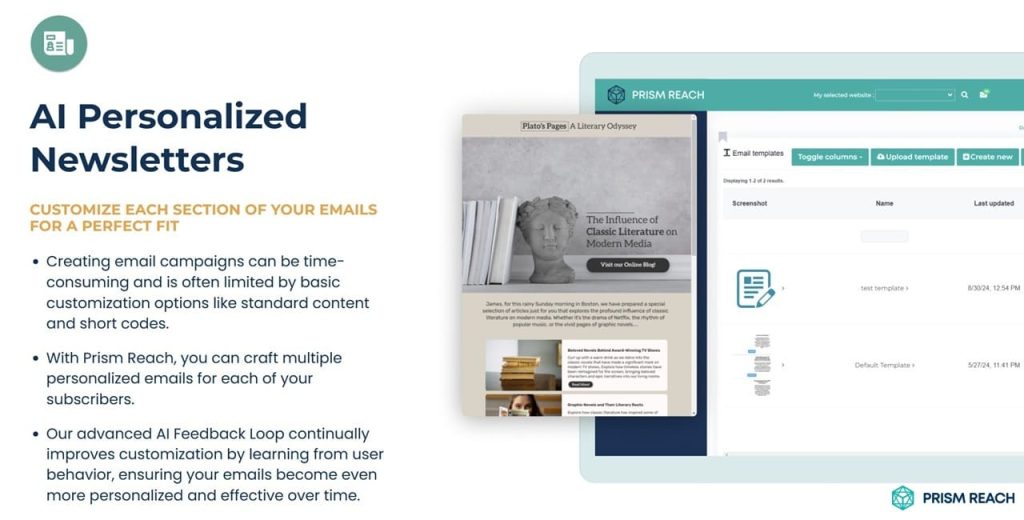
Three Key Benefits of Prism Reach
- Increased Engagement: Publishers report up to 40% higher engagement rates due to the personalized nature of the content.
- Higher Revenue: Tailored advertising and efficient content targeting lead to higher monetization rates for published newsletters.
- Improved Productivity: Automation and AI-driven insights significantly reduce the time required to create and manage campaigns.
Enhancing User Experience with Visuals
Incorporating visual elements such as screenshots can significantly enhance the user experience by providing a clear understanding of the platform’s features and functionalities. Here are three specific places where screenshots could be highly effective:
- Dashboard Overview: A comprehensive view of audience engagement metrics, showcasing open rates, click-through rates, and subscription growth over time.
- Dynamic Content Blocks: Illustrating how content is personalized for each subscriber, demonstrating the ease of inserting automated, audience-specific content.
- Automated Workflow Setup: Demonstrating the intuitive flowchart interface for creating automated email sequences based on user behavior.
Practical Tips for Implementing AI in Email Marketing
Integrating AI into your email marketing strategy can seem daunting, but with the right approach, it can lead to significant improvements in engagement and ROI. Here are some practical tips to help you get started:
- Start with Data: Ensure you have a robust data collection system in place. The effectiveness of AI depends on the quality and quantity of data it can analyze.
- Define Clear Goals: Determine what you want to achieve with AI—whether it’s increasing open rates, reducing churn, or enhancing personalization.
- Choose the Right Tools: Select AI-powered tools like Prism Reach that align with your goals and offer the features you need.
- Train Your Team: Ensure your marketing team is well-versed in using AI tools and understands how to interpret AI-driven insights.
- Monitor and Adjust: Continuously monitor the performance of your AI-driven campaigns and make adjustments as needed to optimize results.
Future Prospects of AI in Email Marketing
The future of AI in email marketing is promising, with advancements poised to offer even more sophisticated capabilities. Here are some trends to watch:
- Enhanced Personalization: AI will continue to refine its ability to personalize content, making emails even more relevant to individual recipients.
- Integration with Other Channels: AI will facilitate seamless integration between email marketing and other digital channels, creating cohesive multi-channel campaigns.
- Advanced Predictive Models: Future AI models will offer deeper insights and more accurate predictions, enabling even more effective marketing strategies.
- Voice and Visual AI: Incorporating voice and visual recognition into email marketing, allowing for more interactive and engaging content.
- Ethical AI Practices: As AI becomes more prevalent, there will be a stronger emphasis on ethical AI practices, ensuring transparency and fairness in marketing efforts.
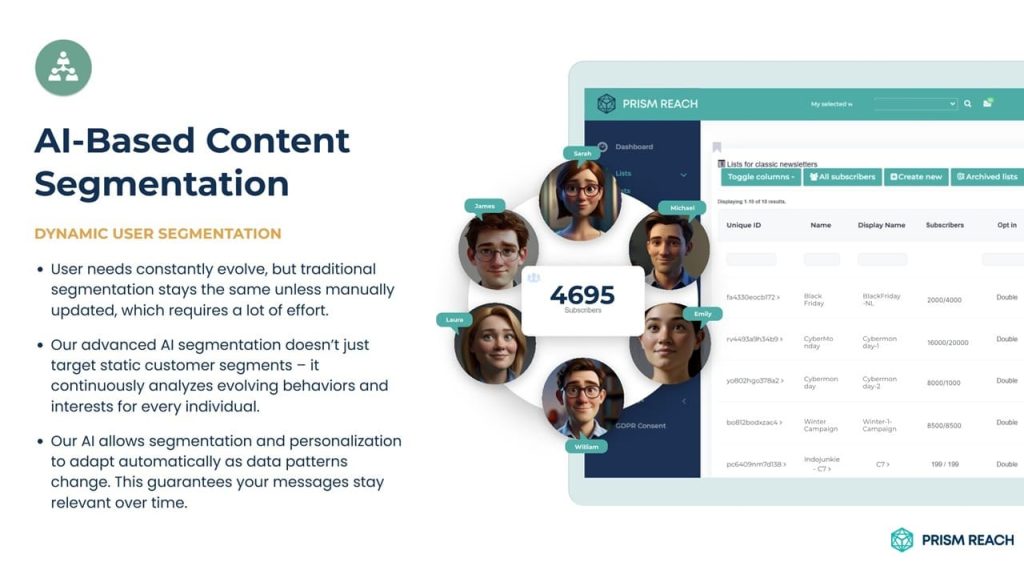
Jumpstart Your Email Strategy with Prism Reach
In the complex world of AI email marketing, Prism Reach stands out as a powerful tool for enhancing and simplifying the process. This innovative AI-powered SaaS solution is designed for publishers, blogs, forums, and eCommerce businesses, offering highly personalized newsletters tailored to individual subscriber interests.
Prism Reach’s key features include:
- Automated Content Aggregation: Seamlessly pulls in content from websites and social media to ensure diverse and relevant newsletter content.
- Creation of Detailed User Avatars: Uses enriched data points to create comprehensive subscriber profiles for ultra-personalized content delivery.
- AI Feedback Loop: Continuously analyzes subscriber behavior to refine and enhance content personalization over time.
- Efficient Newsletter Monetization: Streamlines the process of monetizing newsletters through targeted advertising and content placement.
- Focus on Authentic Content: Ensures that the content remains authentic and publisher-created, maintaining the integrity and trustworthiness of newsletters.
- Strong Data Protection and Privacy Measures: Adheres to GDPR compliance and other data protection standards to safeguard subscriber information.
Overcoming Challenges and Ethical Considerations
While the potential of AI in email and marketing automation is immense, it’s crucial to address the challenges and ethical considerations that come with it. Data privacy and transparency are paramount concerns that must be navigated carefully.
Prism Reach emphasizes GDPR compliance and data privacy, ensuring that all subscriber data is handled with the highest standards of protection. By being upfront with customers about data usage and providing control over their information, Prism Reach builds trust and ensures more accurate AI predictions.
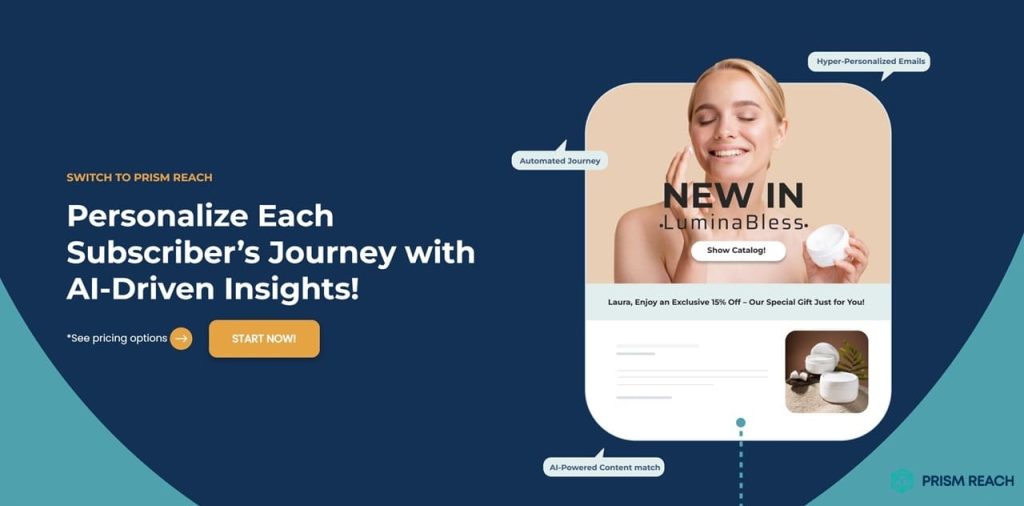
The Human Touch in an AI-Driven World
As we embrace AI, it’s important to remember that marketing is ultimately about connecting with people. While AI can handle data analysis and automation, the human touch remains crucial in crafting compelling narratives and building emotional connections with customers.
Prism Reach strikes the perfect balance between AI-driven efficiency and human creativity. By providing marketers with invaluable insights and automation tools, Prism Reach allows them to focus on creating meaningful and engaging content that resonates on a human level.
Conclusion
The integration of AI into email and marketing automation is not just a trend; it’s a fundamental shift in how we approach customer engagement. From hyper-personalization and predictive analytics to automated optimization, AI empowers marketers to create more relevant, timely, and effective campaigns.
Tools like Prism Reach exemplify the future of email marketing, offering advanced AI-driven features that enhance engagement, increase revenue, and improve productivity. By leveraging AI, marketers can not only streamline their workflows but also deliver content that resonates deeply with their audience, fostering long-term relationships and driving sustained success.
As we look to the future, embracing AI-powered solutions will be crucial for staying competitive and achieving sustained success in digital marketing. The future of email and marketing automation is here, and it’s powered by AI. Are you ready to embrace it?
Sources
- DigitalOcean: AI Email Marketing
- Mailmunch: AI Email Marketing
- Mailmodo: 9 Ways to Use AI in Email Marketing in 2025
- HubSpot: AI Email Marketing: How to Use It Effectively